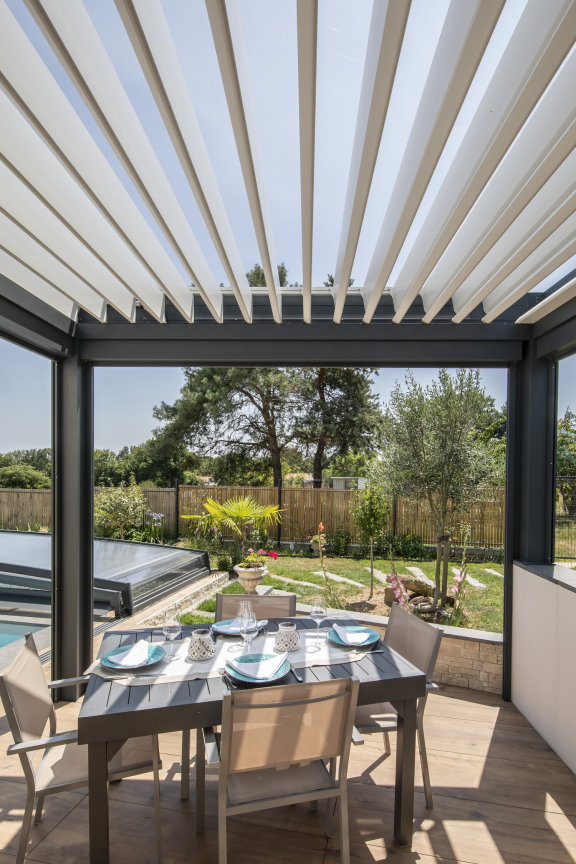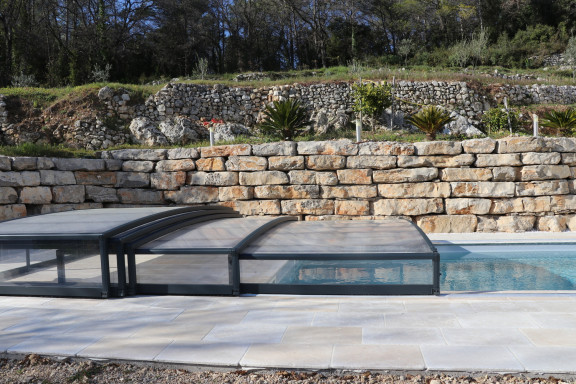When should you choose a folding-roof pergola?
The installation of a pergola can completely transform your exterior and enable you to reap the maximum benefit. However, there are many different models of pergolas, and each has its specific advantages. You may be wondering when to choose a folding-roof pergola and whether this type of extension is really essential for your home. Discover everything you need to know about pergolas, and about models with modular roofs in particular.
What is a pergola?
A pergola is an outdoor installation that enables you to create a sheltered area. They are often installed on a terrace, but can also be situated elsewhere on your property, especially by a pool. Pergolas are not only designed for houses, they can also be installed on the balcony of a flat.
A bioclimatic pergola adapts to weather conditions thanks to features that enable you to easily cover or uncover your terrace. With different types of roof, a range of materials and specific features, a pergola can easily adapt to all your needs.
Create shade
The main use of a pergola is to provide shade. Although sunshine is pleasant, it is not always welcome when your terrace is entirely exposed, especially during very hot weather!
A pergola thus creates shade and enables you to remain outdoors without exposing yourself to UV rays. You can easily enjoy your outdoor area for a meal or a relaxing afternoon, with no fear of being exposed to full sunlight.
Take more advantage of your outdoor area
By creating shelter, a pergola helps you benefit from your outdoor area later in the season. You can thus still spend time outdoors even when it rains, or relax on your terrace without worrying about having to run back inside in a panic when bad weather threatens.
Certain models are equipped with sliding doors to create an enclosed space that you can use year-round.
Protect your garden furniture
A garden lounge will necessarily deteriorate with time, notably due to exposure to the sun and rain. Thanks to a pergola, your garden furniture will be a little more protected and will better survive the rigours of time.
Create a warm and hospitable space
By determining a precise area, a pergola enables you to plan a layout that creates a warm and hospitable space. You can enhance it with festoon lights, plants or cushions for pleasant moments among family or friends. When you install a pergola, you add an additional living space to your home.

How can you washthe structure of a bioclimatic pergola?
Like for adjustable slats, the maintenance of the structure of a wood or aluminium bioclimatic pergola is extremely simple and accessible to all. A simple wash with soapy water and a soft cloth is enough to restore the original appearance of a bioclimatic pergola, enabling your terrace to maintain its attractive appearance. To eliminate the most stubborn dirt on the uprights, black soap or household vinegar diluted in water is often an effective solution. In all cases, it is recommended to rinse with clear water. To save time, it is possible to hose the structure as long as you limit the power of the jet. However, a Kärcher-type pressure washer should never be used on any part of a bioclimatic pergola due to the risk of permanent damage.
Maintaining the gutters of a bioclimatic pergola
The guttering is one of the sensitive parts of a bioclimatic pergola. To enable gutters to perfectly fulfil their function, it is important to ensure that they are never clogged. When maintaining your bioclimatic pergola, remember to remove all the dead leaves or twigs that may have found their way there.
Washing your pergola lighting
Did you opt for a built-in LED lighting system when you chose your bioclimatic pergola? Simply use a wipe or a slightly damp cloth to clean the spotlights or wall lamps.
Cleaning the glazing or blinds of a bioclimatic pergola
Is your bioclimatic pergola fitted with glazing to improve protection against the wind and/or increase privacy? Like for a veranda, remember to clean the slider rails in addition to the interior and exterior of the glazing. A small manual vacuum cleaner may be useful to remove any gravel and other elements that can hamper the proper operation of the rails. To remove spots from the cloth of your blinds, use warm soapy water and gently brush the surface. Then hose the blind with low pressure and allow to dry.
How often should you wash your bioclimatic pergola?
The frequency of maintenance of your bioclimatic pergola mainly depends on the geographical location of your home. In most towns in France, maintenance twice a year is enough to preserve the aesthetic appearance and proper function of the structure, with:
- A first maintenance at the end of winter or early spring to prepare the bioclimatic pergola for the arrival of summer conditions;
- A second maintenance in autumn, to remove any dead leaves that can stagnate on the bioclimatic pergola during the winter season, endangering its proper function (clogged gutters and downpipes causing leakage problems).
The recommended frequency of maintenance for a bioclimatic pergola is significantly different for structures in urban or industrial areas (3 times a year) or coastal environments (4 times a year). In winter, it is sometimes necessary to carry out one-off maintenance to eliminate any accumulations of snow on the roof, the weight of which can be dangerous for the adjustable slats. To avoid this problem, it is often recommended to place the slats of bioclimatic pergolas in the open position when significant snowfall is announced.
Cleaning a bioclimatic pergola: consult the maintenance guide
After the installation of your bioclimatic pergola, the company you have entrusted with your project will often offer you a maintenance guide. In this document, which you should keep, you will generally find all the steps for the maintenance of a bioclimatic pergola, as well as the frequency. In case of doubt, remember to consult the guide or ask your installer for advice. If necessary, don't hesitate to call on a professional to clean your pergola.


